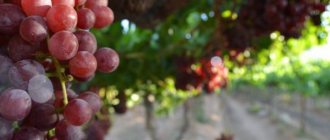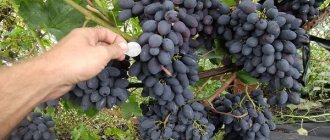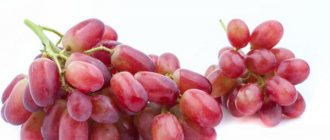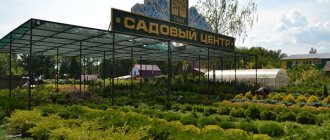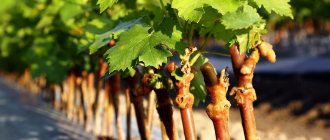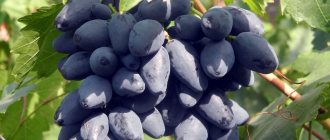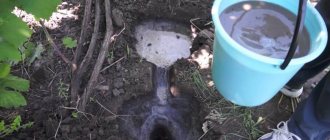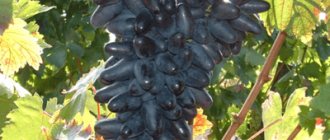Properties
The properties of white grapes differ significantly from dark varieties, and Riesling is no exception. Having a technical purpose, it can be used, if desired, as a dessert, but only if it is fully ripened in favorable weather. Read this article on how to grow grapes from seed.
Calorie content
Calorie content of berries 43kcal/100g.a
Benefits and harms
Green grape varieties, including Riesling, have a beneficial effect on the heart and prevent the appearance of malignant tumors. The main value is the catechins contained in the berries, which improve the health of the body as a whole. Also, eating ripe grapes helps prevent the following diseases:
- Alzheimer's disease;
- ischemia of the heart and brain;
- disturbances in the functioning of the nervous system.
If you are prone to intestinal disorders, eat berries in small quantities so as not to provoke diarrhea.
To improve the health of the body, it is enough to eat 100 g of grapes per day.
There are particularities regarding the consumption of grapes by people with diabetes. The glycemic index of Riesling berries is 45. It is not recommended for diabetics without certain restrictions. At the same time, if no more than 50 g of berries are consumed per day, there will be no harm if the patient’s condition is satisfactory. Read about the benefits and harms of Moldova grapes at this link.
A negative effect from eating Riesling grapes is possible only if it is eaten in excessive quantities - more than 500 g per day. It is also not recommended to eat it during exacerbations of gastrointestinal diseases. If you are obese, grapes are eaten in minimal quantities.
Acidity
Average sugar content 20%. Average acidity up to 11 g/l.
Features of production technology
Dry Riesling is produced from barely ripe berries picked in September-October, while dessert Riesling is made from grapes picked in November-December. The sweetest wines are made from frozen botrytised (covered with noble mold) berries.
Due to its high acid content, Riesling continues to “ripen” even in bottles. In order to acquire new, even more noble taste qualities, it needs 10-15 years. The taste and aroma of wine largely depend on the terroir (region) and aging time. Young Riesling smells of geranium, green apples, pears, peaches, and lemon. In a more mature drink, notes of raisins, dried apricots, and burnt bread crust appear. Old wine acquires the aroma of honey, wax, and silicon. Well-aged Alsatian Riesling can emit a specific smell of kerosene or burnt rubber. This is especially true for wine from areas where the berries ripen too quickly.
Traditional Riesling color
Characteristics of the bush
The characteristics of the plant are attractive both for those involved in professional cultivation of grapes for wine production, and for amateur gardeners who are interested in obtaining fruits for fresh consumption.
The bush is vigorous, actively branching. The foliage is good. The leaves are thick, five-lobed. The leaf blades have a shallow dissection, are slightly pubescent, their upper side is intensely wrinkled. The color of adult leaves is light green, young leaves are bronze. They open late, which is why the plant is characterized by increased frost resistance and does not suffer from return frosts. Young shoots are thin, green in color, branched.
The bush is medium-sized with a corresponding increase in the ripening of the vine.
Vine flowers are bisexual. They fall off quite quickly, which is why, with a lack of pollinators, the harvest is not high. With high-quality pollination, after flowering, a bunch of small green berries is formed, which, under favorable weather conditions, will fully develop.
The plant's resistance to most major diseases is not high. The variety is less susceptible than others only to mildew, a problem that appears in wet weather.
Vine
The Riesling vine is one-year old and small. Well ripened. It has a cylindrical shape and a light brown color. The woody leg is short up to 14 cm.
By performing pruning, the vine is given a certain and convenient shape for caring for it and sheltering for the winter (if shelter is planned).
Bunch
The weight of one bunch is about 100 g. About 70-80 berries are collected in a brush. They fit tightly together and are not prone to rotting. The bunch of berries has a short stalk up to 3 cm long.
The taste of the grapes is rich. They are sweet and juicy with a characteristic smell. The berries ripen in 5-6 months, depending on weather conditions and the region of growth. Harvest occurs at the end of September.
The berries are not large - about 15 mm in diameter. The Preobrazhenie variety has large berries. The shape of the grapes is round, in rare cases slightly elongated. The color is white-greenish or golden. As the berries ripen, their characteristic brown spots appear. The skin of the grapes is thin and at the same time quite dense, ensuring high transportability of the crop. There are from 2 to 4 seeds in berries.
The ripeness of the berries occurs after 5-6 months.
Productivity
The yield of the variety is not high, since clusters are formed on only 87% of shoots, and there is an average of 1.6 clusters per shoot. If the culture is not standard, then on average there are 1.2 bunches per shoot.
If the harvest is abundant, but the vine is very poorly developed, this indicates its imminent death. The plant tries to preserve its appearance with an abundance of seeds.
Riesling classification
German Rieslings (as well as Austrian ones) have a number of classifications.
Tafelwein
(Tafelwein) - table wines with a minimum alcohol content of 8.5%.
Qualitatswein Bestimmter Anbaugebiete, QbA
(Kvaletswein Beshtimter Anbaugebiete) - high-quality wines from various regions that meet established requirements.
Qualitätswein mit Prädikat, QmP
(Qualitieswein Mit Predicat) - wines of the highest category. They, in turn, are divided according to sugar content as follows:
Kabinett
— the driest rieslings, light and elegant. Pairs well with seafood, Thai cuisine, sushi, vegetables, as well as light poultry or pork dishes.
Spatlese
- elegant and rich Rieslings with pronounced fruity aromas, made from late harvest grapes. Typically dry, medium body. Suitable for spicy dishes, lobsters, scallops and fish, pork, smoked meat.
Auslese
- wines made from the ripest grapes, sometimes sweeter than spatlese. An excellent pairing for avocado, fatty cheeses, crab and foie gras.
Beerenauslese
- sweet Rieslings with a rich palette of aromas, made from botrytised grapes. They are not released every year and are stored for a long time. Suitable for fruits and pies.
Trockenbeerenauslese
- sweet, rich Rieslings made from raisin grapes. Their consistency resembles nectar, and the aroma is dominated by honey shades and exotic fruits. They have great storage potential. Pairs with apple pies, tropical fruits, and caramelized desserts.
Eiswien
- the upper echelon of dessert wines and a dessert in itself. It is made from berries frozen on the vine (at temperatures below minus seven degrees), which cannot be obtained every year. The juice of such grapes is very concentrated and contains a large amount of sugar.
Growing
The life of a plant and the quality of the resulting harvest directly depend on how correctly it is grown. For seedlings, it is necessary to select a suitable site that meets all the requirements. A special feature of the Riesling variety is that if it is grown in a hot climate, the quality of the fruit drops sharply, which negatively affects the taste of the wine. This grape needs cool weather, similar to that found in its homeland in Germany.
With proper planting and proper care, the vineyard can bear fruit for up to 50 years.
Planting period
Planting is carried out in spring or autumn. The main condition is that the air temperature at this moment does not exceed +15o. If the area experiences very cold winters, it is better to plant plants in the spring so that they have the opportunity to fully take root and not freeze. Read about planting and caring for virgin grapes here.
When planting, it is necessary to maintain a distance of 120 cm between seedlings. The distance between rows should be 3 m. With this scheme, the development of the vine takes up to 10 years, and the vineyard’s yield will be maximum.
A planting site needs light shade and no strong wind. The soil requires somewhat poor limestone. This will allow you to get berries with the maximum content of nutrients. The soil should be constantly moist, but not swampy and well ventilated. The ideal place to create a professional vineyard is a rocky slope.
Riesling loves calcareous and not very fertile soils.
Plants are planted in trenches 70 cm deep. In a garden plot, planting is carried out in holes with a diameter of 60 cm and a depth of 70 cm. A layer of nutritious soil (10 cm deep) is poured into the trench or hole, from which a mound is formed. The seedling is placed on its top, and the roots are distributed along the slopes. The plant is covered with soil, which is then compacted around the trunk. After planting, the grapes are watered with warm water. Then, until complete rooting, it is necessary to water the plantings every 14 days.
Seedlings must be completely healthy and free of mechanical damage.
The best seedlings are 20 cm high and have well-developed, not overdried roots. There must be at least 5 buds on the top shoot. Immediately before planting, the ends of the roots are slightly trimmed. Then for 10 minutes the root is placed in a solution of root growth stimulator or succinic acid.
Planting grapes is a long process that requires special attention.
If the seedlings are planted in the spring, the first harvest can be harvested within a year. When the plant is planted in autumn, it bears fruit from the age of 3. The first harvests are modest. If the winters are very harsh, then fruiting may be delayed for another year. Find out about the Cabernet Sauvignon grape variety here.
Ripening time
From the moment the buds open until the harvest takes place from 140 to 160 days. At the end of September, characteristic brown spots appear on the berries, which indicate ripeness. Read about grafting grapes in spring in this material.
Possible diseases and pests
Riesling grapes are vulnerable to various diseases and pests, except mildew. It is most often affected by:
- oidium. This fungal disease is otherwise called powdery mildew. Symptoms are a smoky-white light coating on the leaves, shoots and fruits. The first signs are the appearance of light spots on the leaves. Treatment and prevention - removal and destruction of all affected parts of plants, treatment with colloidal sulfur. Prevention - spraying the bushes with a solution of copper sulfate or Azofos;
- gray rot. The disease occurs with high humidity. The first manifestations are brown spots on the leaves. Necrosis is observed on the shoots and branches, the inflorescences turn brown and dry out. A gray fluffy coating appears on the fruits, they begin to wither and fall off. To prevent disease, in the spring the vine is treated with fungicides Mikal, Folpan, Antraknol. They are treated with the drugs Topsin-M, Topaz, Roval;
- bacterial cancer. This disease is considered one of the most severe and cannot be cured. The only way to protect the vine is prevention. Symptoms are the appearance of a tumor, often closer to the root. Plants become weak and their productivity decreases. When purchasing, it is necessary to inspect seedlings for this disease. Before planting, cuttings must be treated with a disinfecting solution. Sick bushes must be removed and destroyed. The land where such a bush grew must be treated with disinfectants.
Gray rot of grapes.
The most dangerous pests for Riesling grapes are:
- phylloxera - grape aphid;
- cluster leaf roller.
Insecticides Marshall, Zolon, Mitak, Actellik, Confidor will help fight phylloxera. The leafworm will be driven away by the drugs Coragen, Probrand, Match, Decis.
Care
Proper care prevents the occurrence of many diseases in the plant and ensures maximum yield. Agricultural technology when growing vines for the current season comes down to timely watering, fertilizing, pruning and weeding.
Adult plants are watered abundantly at the root 2 weeks before flowering. If the weather is humid, then watering is not required. Also, you should not water the bushes during the period of active development of young shoots. In areas with an arid climate, the vineyard should be watered 3 times per season: 2 weeks before flowering, at the time of active filling of berries and 2 weeks before frost . When watering, you should try not to wet the leaves of the grapes, as this can provoke the appearance of diseases.
Fertilizing is carried out once during the rooting period of seedlings. To do this, after loosening the ground and removing weeds, scatter wood ash around the plants. When watering and during rain, it will penetrate the soil and nourish the seedlings. 4 years after planting Riesling, mandatory fertilizing is carried out, without which fruiting will become insufficient. Ash is also used for it.
The soil must be systematically processed throughout the spring-autumn season, and all weeds must be removed immediately.
Weeds must be removed as soon as they are noticed in the vineyard. After weeding, you need to immediately loosen the soil, which will ensure good root respiration, which is necessary for the full development of the vine.
Disease Prevention
The Riesling variety is not resistant to bacterial cancer, powdery mildew and gray rot. Among the pests, the variety is often affected by grape budworm and phylloxera. Prevention allows them to prevent damage.
It is extremely difficult, and sometimes impossible, to exterminate pests and cure plants if they are sick. Strong plants suffer less from diseases, and therefore it is necessary to constantly properly care for the grapes and cover them for the winter, despite their increased frost resistance. Also, you should not leave organic waste on the site after pruning or weeding. They become a haven for pests. Also, water begins to accumulate in them after rains, and due to increased dampness, fungi develop. The use of medicine against fungal infections of grapes gives results only if the infection is not abundant. Treatment, if the disease does not spread, is recommended to be carried out in the spring or autumn after harvesting, and in case of rapid spread of the disease - at any time. However, after this, due to the use of special drugs, the berries cannot be eaten.
Treatment of plantings against pests should be carried out annually, until the buds open. If the risk of plant damage is very high, then repeated treatment is carried out after the leaves open, but before flowering, so that the chemical compounds do not get into the ovary.
Botrytis cinerea is a mold that has a beneficial effect on Riesling berries. Thanks to it, the percentage of moisture in the berries decreases, and the amount of minerals and sugars increases.
Wasps love the berries, and to protect the crop from insects, you need to use special bags that are placed on the bunches. Hanging baits that contain honey syrup with added toxic substances also help.
The use of any chemicals after the ovary begins to form, otherwise it will be impossible to eat the grapes.
Trimming
Pruning the plant is required so that it branches more actively and at the same time does not become thickened. If grape bushes are not pruned, they quickly reduce their yield, and the berries become smaller and become sour.
The process of pruning and shaping is repeated for 3-6 years until the bush acquires its optimal shape.
Pruning is carried out a year after planting. In the spring, the plants are inspected, and if they are strong and not frozen, then 2-4 buds are cut from each branch. When pruning, the bush is shaped in such a way that it is as convenient to care for as possible. Formation ends after 6 years, when the plants have already taken their final form. From this moment on, the pruning rules change.
On mature grape bushes, only annual growths and weak shoots that will not survive the winter are cut off in the fall. In the spring, after it becomes clear which part of the plant is alive, dry and frozen shoots are cut off. If only the top is frozen, then it is cut off to the first healthy bud. If a thick branch is cut, the cut site should be covered with varnish to reduce the risk of infection and prevent weakening of the plant due to loss of sap.
A little history
The history of the Riesling grape stretches back centuries. The first time this grape was mentioned was around 400 BC in the poem “Mosella”, written by Ausonius. It is believed that the Riesling variety first grew wild in the valleys of the Rhine and Moselle rivers, and then was cultivated and migrated to other countries.
The first seedlings were planted in the 15th century in Germany along the southern wall of Russelsheim Castle. Today, two-thirds of all Riesling grapes grow in Germany, and they are also found in other countries - the Czech Republic, Austria, France, Hungary, Bulgaria, Switzerland, Moldova and the USA.
Riesling wine at first had a rather mediocre reputation, until a certain incident occurred: a messenger who was carrying permission to harvest grapes lost his way and was lost for two weeks. While he was looking for the right path, the grapes became overripe and became moldy. It was from these grapes that first-class wine was produced, which became a huge success.
The result obtained was consolidated by Abbot Fulda, who acquired the ruins of the Johannisberg monastery and restored the vineyards located in it along with the monastery. This is how Riesling gained popularity first in Germany and then throughout Europe.
